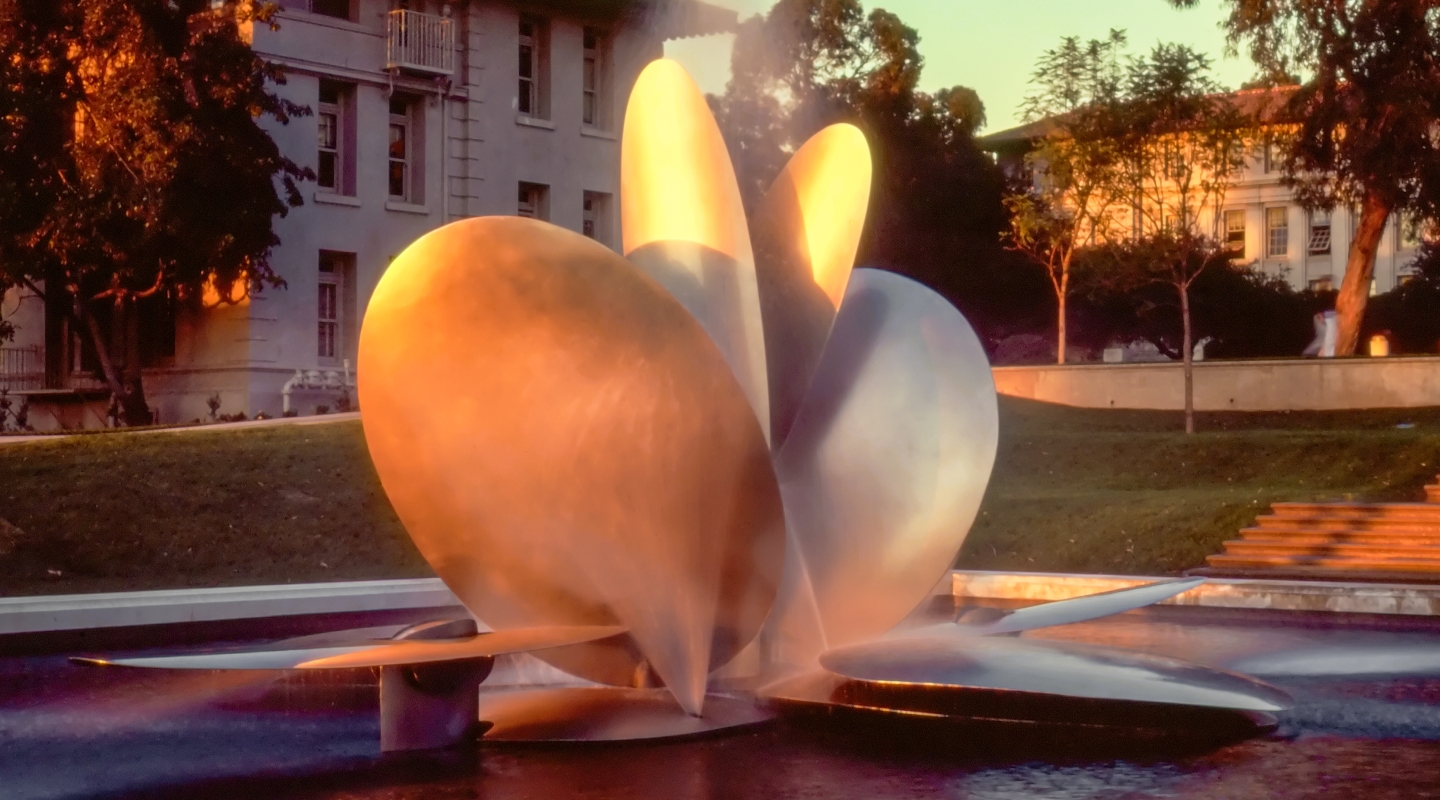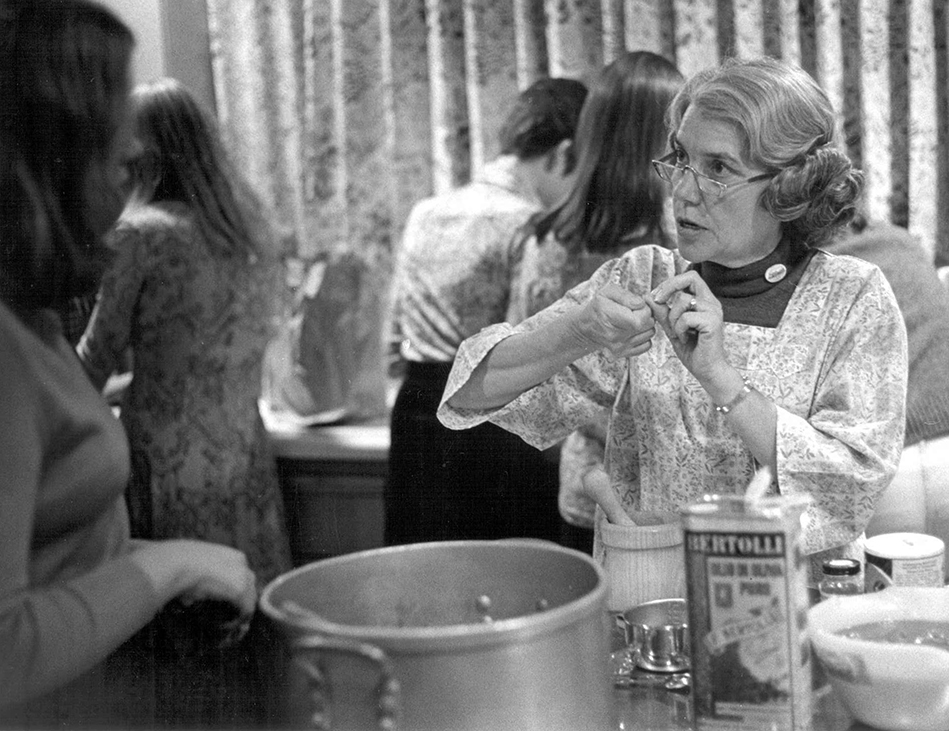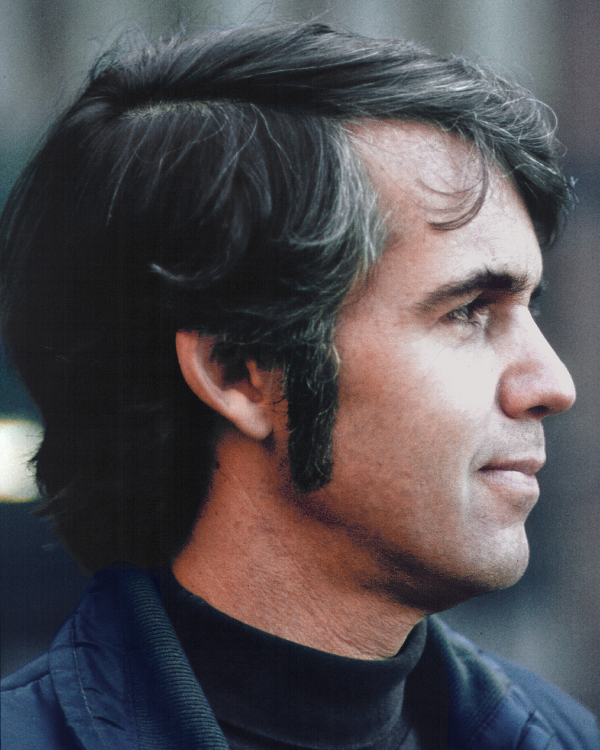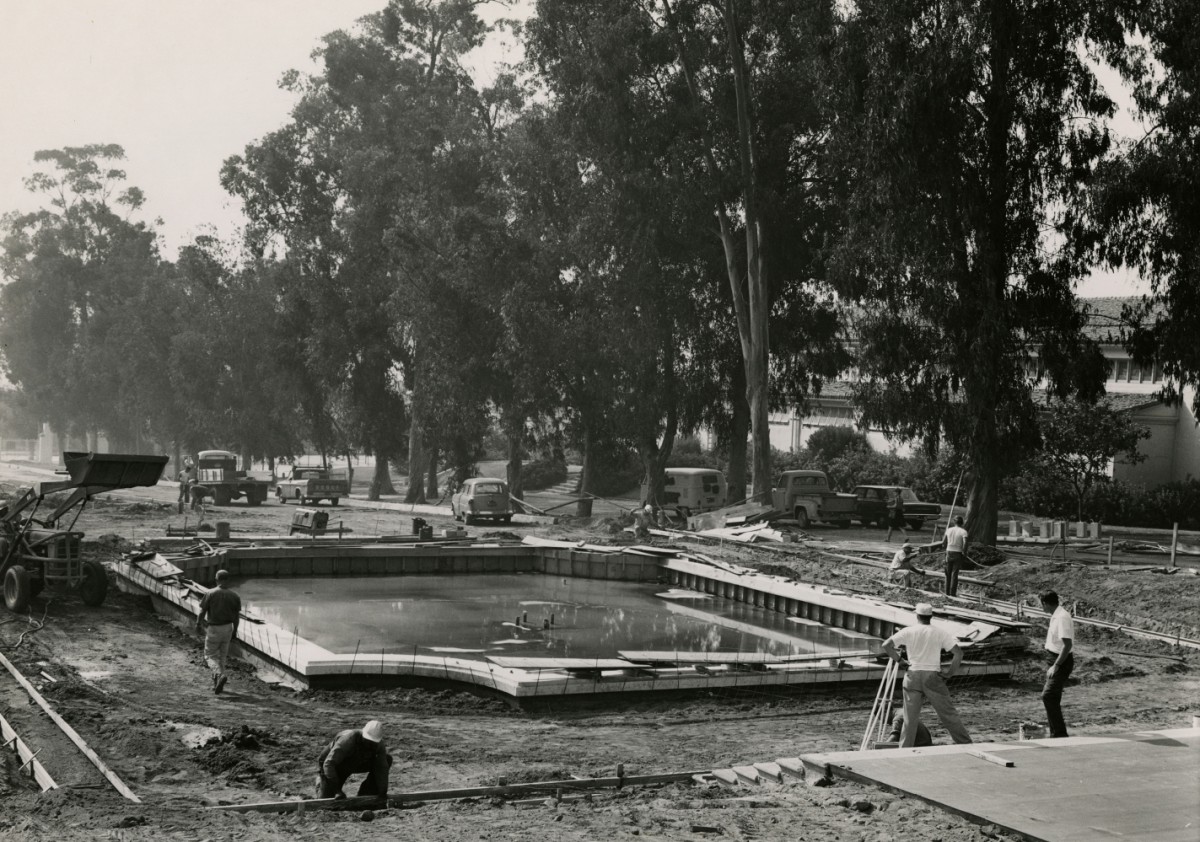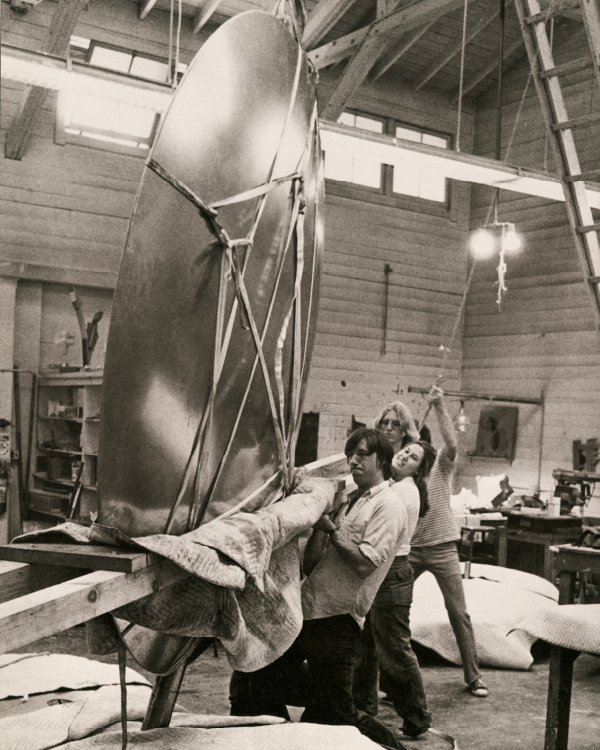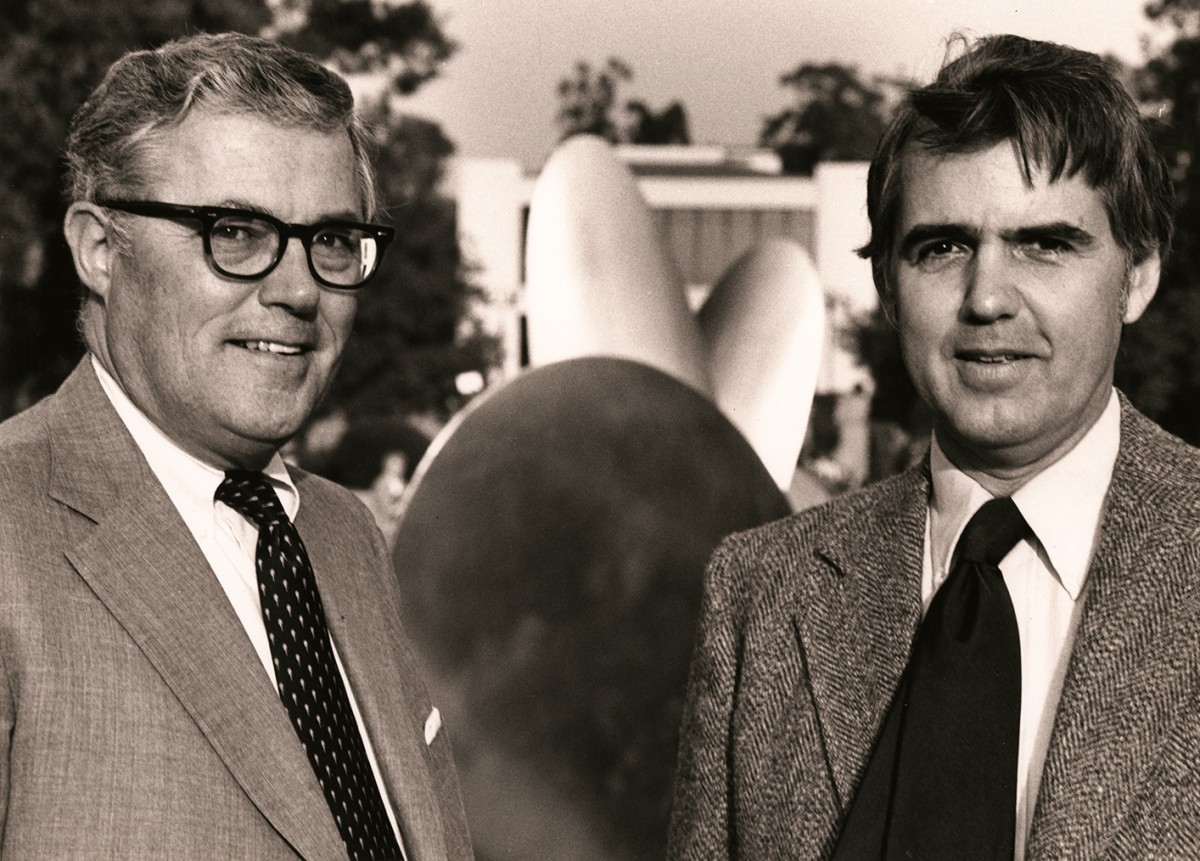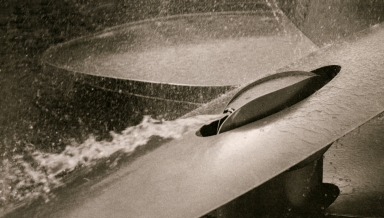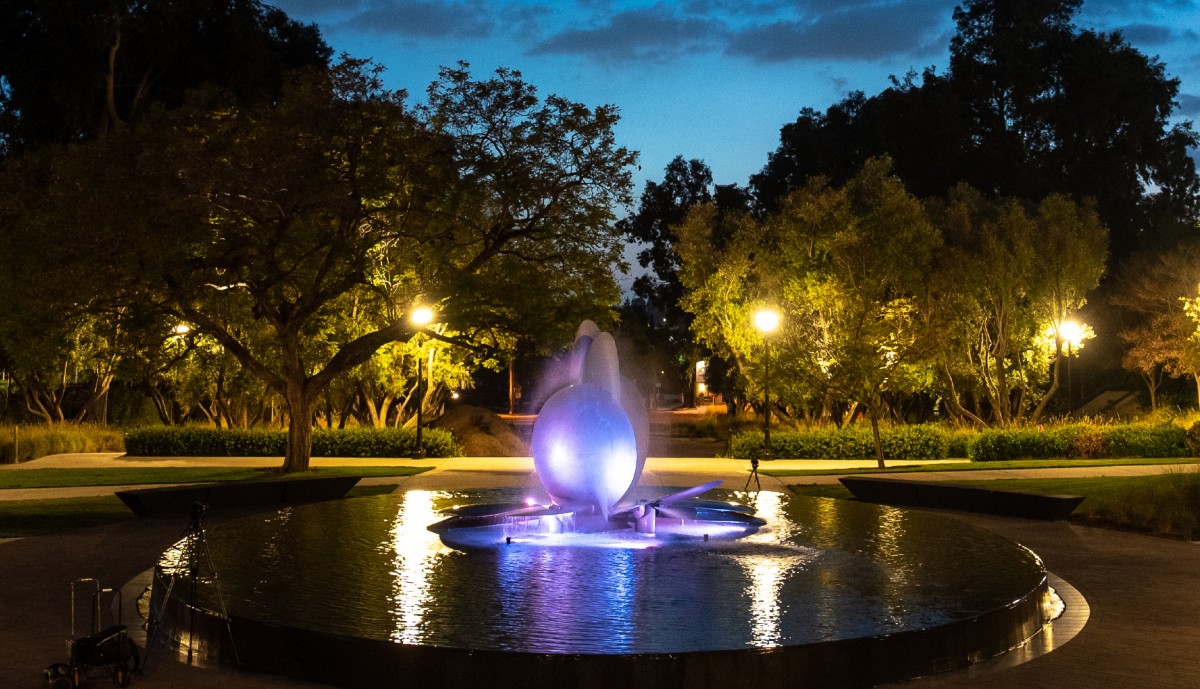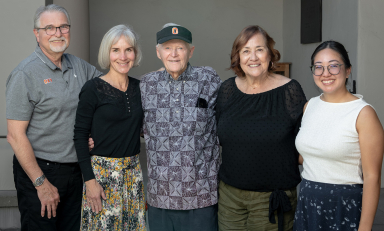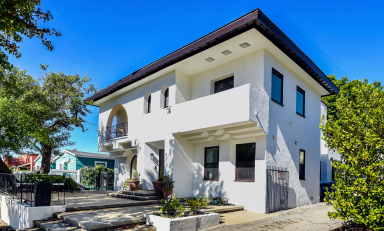The Lucille Y. Gilman Memorial Fountain—formally known as Water Forms II—occupies a prominent place on campus and in the hearts of generations of alumni. George Baker ’58’s former students recount the story of how it all came together
During the fall quarter of 1977, psychology major Sheldon Marks ’78 enrolled in a sculpture class taught by George Baker ’58, a rising star in the world of abstract metal sculpture. “Deep down inside I always wanted to be a sculptor,” Marks explains, “and when I met Mr. Baker, I did all I could to get into his class to see if I had any skill.”
As it turned out, Marks showed some skill as a sculptor, and Baker was very complimentary of one of his creations. But the premed student ultimately used his manual dexterity as a surgeon, and his most lasting contribution to the class—and the College—was to promote Baker’s artistic vision for a kinetic fountain in the pool adjacent to what is now Herrick Interfaith Center.
Baker had designed a kinetic fountain for Expo ’70 in Osaka, Japan, and a kinetic wind sculpture in a lake near Kearney, Neb., for the U.S. Bicentennial in 1976. He also had created a major installation of hanging disks for the Love Library of San Diego State University. But the artist had no sculptures at his alma mater. Sometime after the Osaka fountain, he had proposed a fountain for the Herrick pool, but nothing came of it.
Lucille encouraged him to discuss it with her husband, who suggested he take it to other senior administrators. (Both the president and Baker felt the idea might gain more traction coming from a student.) Dean of the Faculty Otis Shao found the proposal interesting enough to bring it to the Central Administrative Committee (CAC), composed of Shao, Gilman, Executive Vice President Robert Bovinette, and Vice President for Planning and Development Lee Case.
Recognizing that funding the sculpture would be a challenge, Baker wrote to Shao on December 18, 1977, shortly after the end of the quarter, with a new idea. An Art Department support group called the Art Affiliates had collapsed with $5,000 left in its budget. What if he replaced his regular sculpture class with a special class in which students worked on the kinetic fountain? Baker felt that the class would be a much-needed boost to the profile of the Art Department and that additional services “beyond the capacity of the College” could be covered by the $5,000 in hand: “It seems likely that the College could acquire an asset without cost.”
Like many artists, George Baker was better with ideas than budgets, and the final cost of the fountain was around $40,000. But considering its value to the College as a work of art, a teaching experience, and an iconic Oxy landmark, it seems a bargain today.
Growing up in San Marino, Baker’s path to Oxy was circuitous. His undergraduate studies began at Wooster College in Ohio in 1948. “He was very interested in music and composition, being an accomplished pianist,” Eric Peltzer ’85 wrote in a memorial retrospective of his mentor’s work in 1997. “However, after two years there he became restless, and when the opportunity to visit a classmate’s parents in Afghanistan arose, the two decided to make a year of traveling through India and southwest Asia.”
After graduating from Oxy, Baker earned an MFA in sculpture at USC in 1960 and taught there until he joined the Occidental faculty in the fall of 1964. Throughout his 33-year Oxy career, Baker taught part-time and used the Art Barn (now Samuelson Pavilion) as his personal studio, an arrangement that benefitted both the artist and the College. Oxy students worked on more than 150 of Baker’s sculptures. “If I had not been a practicing sculptor, an active sculptor working on large-scale pieces, I would have had less to offer the students,” he observed in 1995.
In January 1978, soon after writing to Shao with his creative funding proposal, Baker traveled to Berlin to complete a massive kinetic sculpture titled Alunos-Discus for a wall of the German Opera House. This was another idea that had been waiting for funding; it was commissioned by the American Chamber of Commerce in Germany to celebrate its 75th anniversary. Three of Baker’s former students accompanied him to Berlin: Richard Andrews ’71, Peter Greenleaf ’75 (who would play a major role in creating Gilman Fountain), and Kent Margulis ’76. Michael Casey ’68 and Steve Bourg ’79 helped with the project in Los Angeles.
The Berlin sculpture was a high-water mark of Baker’s career on the international stage. Every step of its creation and installation was documented by a dedicated photographer and filmmaker, and the artist was feted at a black-tie reception hosted by the mayor of Berlin. Baker returned to Oxy in mid-May with a new sense of his position as an artist and expectations that were not completely realistic for a small liberal arts college. He and Shao put together a rough budget, including a substantial commission for Baker, which Shao shared with the CAC on June 5. No immediate action was taken.
Three weeks later, on June 26, 1978, Lucille Gilman died suddenly of a cerebral hemorrhage. Warm and generous of spirit, she was much beloved by students like Mark Rountree ’79, who had become close to her through the cooking class. “Cooking was perhaps the least of the skills Mrs. Gilman taught us,” he later wrote. “In short, we learned about living a good life, living it fully and responsibly, and being a good citizen.”
Almost 100 Oxy faculty, administrators, and friends of the Gilman family contributed to a fund in Lucille’s memory, and President Gilman decided that the perfect use of the donations would be to fund the fountain in her name. The Board of Trustees approved the use of the funds for that purpose in October, and the project shifted into gear.
Baker provided a small model, called a maquette, in December, and Ty Cunningham ’79 worked with him over the holidays to create mechanical drawings to be approved by an outside structural engineer. Erik Williams ’79 worked on hydraulic engineering, and Greenleaf was put on salary for the winter and spring quarters as Baker’s chief assistant. The sculpture would be called Water Forms II.
In a classic conflict of art and practicality, Baker butted heads with Bob Farley, a former naval officer turned Oxy’s director of facilities. “Nothing we are planning is like going to the Moon,” Baker wrote in exasperation. Steve Rountree ’71, who currently chairs the Occidental Board of Trustees, was at the time Farley’s boss as associate vice president in charge of human resources, facilities, food services, and other operational matters.
“There were budget, engineering, and construction issues from the outset,” Rountree says. “My role was, on the one hand, to help convince the construction and facilities people to bend to meet George’s aesthetic goals and, on the other hand, to explain realities to George when something just wasn’t possible.”
Rountree would later become an arts administrator with the Center Theatre Group, the Music Center of Los Angeles County, the Los Angeles Opera, and the Getty Trust—“a long career in which my principal job and expertise has been handling and supporting and wrestling with artists, musicians, dancers, actors, singers, architects, curators, and intellectuals,” he says. “That is what I did, and it began with George Baker.”
In mid-February 1979, Baker made a presentation to the Board of Trustees, which approved additional funds to assure completion of the project. A few days earlier, an article appeared in The Occidental explaining the special class, which would be split into two sessions, one in the morning and one in the afternoon. Baker and Greenleaf interviewed 27 applicants and chose 12 students, a mix of men and women from a variety of majors. There were also a few students who worked on the sculpture without being officially enrolled in the class.
Students joined the project for various reasons. “The Water Forms project looked like fun and appealed to the ‘fabricator’ in me,” writes chemistry major Victor Macko ’79.
Kirk Lord ’81, a biology major with a studio art minor, had done a lot of drawing, painting, and small-scale sculpture and was excited about the chance to build a full-scale, functional piece. “George’s stature in the sculpture world made it even better,” he says. “The idea of being a part of something that would become a permanent fixture on Oxy’s campus was pretty motivating.”
Lord enlisted his roommate John Castner ’81—who was not interested in art but liked the idea of a memorial to Mrs. Gilman. “George was a practical man,” Castner recalls. “I think he took one look at Kirk and me, our size and condition, and knew immediately that we could handle the grunt labor.”
Studio art major Lorraine Fiamenco ’80 had failed a previous sculpture class due to a bout with mono and needed a 3-D art class to graduate. “George took pity on me,” she says. “Being part of a team was great, and it was refreshing to interact with folks who had other interests. Helping Baker realize his vision was inspiring.”
Mark Rountree applied because of his affection for Mrs. Gilman and a desire to understand the “mystery” behind Baker’s art. He enlisted Ben Bauermeister ’82, who was in the freshman Collegium and could not sign up for the class. “Mark was my head resident,” Bauermeister explains, “and he knew that I was interested in art. He told me, ‘You need to get involved in this program, just go down there and start helping out.’”
Baker put the freshman in charge of ordering bearings, and Bauermeister recalls that “it kind of blew my mind” when he opened the bearing book and saw that it belonged to renowned kinetic sculptor George Rickey. “This guy was friends with George Rickey. That’s when I knew I wasn’t dealing with just any artist.” He was so inspired by Baker and the experience that he became a sculpture major.
The class began with training during the last week of March, and 12 large sheets of thick stainless steel arrived in the Art Barn the following week. Although Baker was detail-oriented in his artistic vision, Greenleaf acted as foreman on a daily basis, working with the outside contractors and performing tasks that could not be done by the students.
“Baker and Greenleaf provided a good balance of leadership for the group,” Mark Rountree wrote at the end of the project. “The usually quiet and concerned Baker tends to lean back in reflection on each step of work, while Greenleaf, who has an energy level of nuclear proportions, charged around the Art Barn with the sort of determination needed to build a two-ton fountain.”
“They would cut, grind, sand, drill, and tap holes,” Greenleaf recalls of the students. “They would tote, carry, and haul. They were great.”
The sculpture is composed of 13 large pieces of heavy stainless steel, eight circular shapes and five elongated “surfboard” shapes. The students’ primary responsibility was to cut and polish the pieces—a process that Macko describes with impressive clarity after 42 years:
Fiamenco remembers that women did the same hard work as the men but also had some specialties. “We women liked running the power tools, and tended to excel at more precise tasks like nibbling the shapes from the formed stainless steel or crawling under to reach fittings in small spaces. It was demanding work physically, but we were all in great shape at the time.”
Castner was tasked with dropping off and picking up shapes at the rolled steel forming company in the City of Commerce. “They flipped me the keys to the plant department truck, gave me the address to the vendor, and told me to drop off the shapes. George trusted us to get the job done.”
As the project neared completion, Baker considered the question of how to haul the heavy steel pieces to the pool site for installation. “At the end of an afternoon session, on a hot day, George asked me if I would like a beer,” Castner recalls. “Are you kidding me? Of course! I was sipping my beer, reflecting on the day's work, and listening to George and Erik Williams talking about having the facilities department remove a portion of the Art Barn roof, rent a construction crane, place it in the Quad, lift the heavier pieces out of the Art Barn, move them and place them in the fountain for installation.”
Castner apologized for eavesdropping but suggested that manpower was “cheap, reliable, and readily available” in the form of his ATO fraternity brothers. “I told George that if he could design and build a contraption that would hold and balance the shape in place, I could deliver eight ATOs to do the heavy lifting, and it would be far cheaper than a new roof and crane rental. He asked me on the spot for a labor estimate. The ATOs were always up for a weekend party, so I suggested two kegs of Heineken and two fifths of Jack Daniel’s. He grinned and said, ‘Done.’ I think we actually shook hands on it.”
Macko, the natural fabricator, came up with the design for the contraption: “We purchased four long wooden 4x4s and laid two of them on either side of the disk. Double 2x4 blocks were bolted to the 4x4s to enclose the disk below the apex of the curve, trapping the piece securely. The burly ATO fraternity members easily lifted this ‘sedan chair’ and marched the two biggest disks down to the fountain, where we added two more 4x4s as crosspieces, to make it easier to maneuver. They lifted each disk again and set it into the prepared mount. The whole process took about an hour.”
After moving the disks, Castner and his fraternity brothers walked back to the ATO house and found two ice-cold kegs and two fifths sitting on the front porch. “Nobody saw the delivery,” he recalls, “and nothing further was said about it. Everybody was happy.”
Water Forms II—26 feet long, 15 feet wide, and 12 feet high—was fully installed by the end of the school year. Baker and Williams spent the early summer working on the timing sequences of the pump and making adjustments to the balance and water flow. There were 13 nozzles controlled by three individually programmed motor valves. (With electronics still rudimentary, programming involved cutting notches into cams for the timers.) The full program of water patterns, intuitively developed by Baker, would repeat every 15 minutes, with the direction and velocity of wind further influencing the water to create theoretically infinite subtle variations of movement.
“It is only fitting that today this impressive sculpture by Mr. Baker be dedicated to Mrs. Gilman,” noted Marks, then a second-year medical student. “Both have left a lasting impression on Oxy.”
The main speaker was Franklin D. Murphy, a friend of the Gilman family, former chancellor of UCLA, and chair of the Times Mirror Company. He spoke of how four forces came together that afternoon: the spirit of Lucille Y. Gilman, the creative genius of man, the commitment of higher education to the arts, and “the opportunity of generations of Occidental College students to be touched either directly or indirectly by the movement of this fountain.”
Finally, President Gilman noted that many prospective students had visited campus that morning, while droves of alumni were back on campus that day as well. “It’s a very special privilege for me to have this dedication as an integral part of an important day in the life of Occidental College,” he said. “Now, I have at my hands a button, and I’m told that when I press that button this beautiful creature will come into reality.” Pointing the crowd toward the Herrick pool, Gilman pushed the button, and the fountain came to life in an eruption of water and movement.
As Murphy predicted at the dedication ceremony, Water Forms II—the Lucille Y. Gilman Memorial Fountain—has touched generations of Oxy students with its graceful movements, its rainlike spray, and its glistening silver-gray reflections of the world around them. The fountain has graced countless College publications as well as TV shows and films (most notably Star Trek III: The Search for Spock). In recent years, however, the fountain and surrounding pool were showing their age.
According to Tom Polansky, former associate vice president of facilities, the idea of repairing the fountain turned into a complete restoration project, which—with the encouragement of then-President Jonathan Veitch—quickly turned into a transformational project for that section of the campus. The area was regraded for easy access to the fountain space, and the old octagonal, scalloped-cornered pool was replaced with a more elongated elliptical shape, with black basalt walls that give the illusion of an infinity edge as water ripples over the basalt and is recycled into the pool. (In a nod to environmental concerns, permeable concrete pavers in the plaza keep rainwater from flowing into the street.)
Baker’s sculpture was taken apart, cleaned, and reassembled with new joints between the steel panels. The original three valves were replaced with 16 valves, allowing more individualized control. And the old white pool spotlights were replaced with LEDs with “every color in the spectrum,” Polansky says.
For the Oxy community, the fountain is a poignant reminder of Lucille Gilman’s contributions to the College. Son Tucker Gilman writes, “The fountain and plaza area gracefully and warmly welcome people at the front entrance of the Oxy campus, just as Lucille Gilman graciously and warmly welcomed everyone to the College and to the President’s House, whether for her famous cooking class, a holiday open house, or for a faculty or trustee reception.”
Although Gilman Fountain looks much as it did when it was first installed, one key dynamic has changed. The sculpture is not centered in the new, elongated pool, but moved toward the front of the ellipse—exactly where the artist wanted it. “Now it’s in line with the chapel doors,” Polansky says. “We moved it, truth be told, to get the orientation more in line with the central axis to the campus. It just makes a lot more sense now.”
Somewhere, abstractly, George Baker is smiling.
Paul Robert Walker ’75 spent hours studying or socializing by the Herrick pool with the pre-Baker fountain spouting straight into the air.

